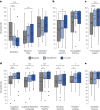Magnesium-ibogaine therapy in veterans with traumatic brain injuries
- PMID: 38182784
- PMCID: PMC10878970
- DOI: 10.1038/s41591-023-02705-w
Magnesium-ibogaine therapy in veterans with traumatic brain injuries
Abstract
Traumatic brain injury (TBI) is a leading cause of disability. Sequelae can include functional impairments and psychiatric syndromes such as post-traumatic stress disorder (PTSD), depression and anxiety. Special Operations Forces (SOF) veterans (SOVs) may be at an elevated risk for these complications, leading some to seek underexplored treatment alternatives such as the oneirogen ibogaine, a plant-derived compound known to interact with multiple neurotransmitter systems that has been studied primarily as a treatment for substance use disorders. Ibogaine has been associated with instances of fatal cardiac arrhythmia, but coadministration of magnesium may mitigate this concern. In the present study, we report a prospective observational study of the Magnesium-Ibogaine: the Stanford Traumatic Injury to the CNS protocol (MISTIC), provided together with complementary treatment modalities, in 30 male SOVs with predominantly mild TBI. We assessed changes in the World Health Organization Disability Assessment Schedule from baseline to immediately (primary outcome) and 1 month (secondary outcome) after treatment. Additional secondary outcomes included changes in PTSD (Clinician-Administered PTSD Scale for DSM-5), depression (Montgomery-Åsberg Depression Rating Scale) and anxiety (Hamilton Anxiety Rating Scale). MISTIC resulted in significant improvements in functioning both immediately (Pcorrected < 0.001, Cohen's d = 0.74) and 1 month (Pcorrected < 0.001, d = 2.20) after treatment and in PTSD (Pcorrected < 0.001, d = 2.54), depression (Pcorrected < 0.001, d = 2.80) and anxiety (Pcorrected < 0.001, d = 2.13) at 1 month after treatment. There were no unexpected or serious adverse events. Controlled clinical trials to assess safety and efficacy are needed to validate these initial open-label findings. ClinicalTrials.gov registration: NCT04313712 .
© 2024. The Author(s).
Conflict of interest statement
N.R.W. and I.H.K. are inventors on a patent application (no. 18/467,324) related to the safety of MISTIC administration as described in the paper. J.P.C. and N.R.W. are inventors on a patent application (no. 18/467,343) related to the use of ibogaine to treat disorders associated with brain aging. J.D., J.I. and T.M. are shareholders in Ambio Life Sciences, which offers ibogaine treatments. J.D, J.I. and T.M. are inventors in a related provisional patent application no. 63/523,774. The application is related to adjunct treatment with various compounds during ibogaine therapy to improve safety. J.D. is founder of Terragnosis, Inc., a company dedicated to the sourcing and semisynthetic conversion of ibogaine precursors to ibogaine. The other authors declare no competing interests.
Figures



References
-
- Traumatic Brain Injury. US Department of Veterans Afffairspublichealth.va.gov/exposures/traumatic-brain-injury.asp (2022).
-
- Hayward P. Traumatic brain injury: the signature of modern conflicts. Lancet Neurol. 2008;7:200–201. - PubMed
-
- Helzer JE, Robins LN, McEvoy L. Post-traumatic stress disorder in the general population. N. Engl. J. Med. 1987;317:1630–1634. - PubMed
Publication types
MeSH terms
Substances
Associated data
LinkOut - more resources
Full Text Sources
Other Literature Sources
Medical

